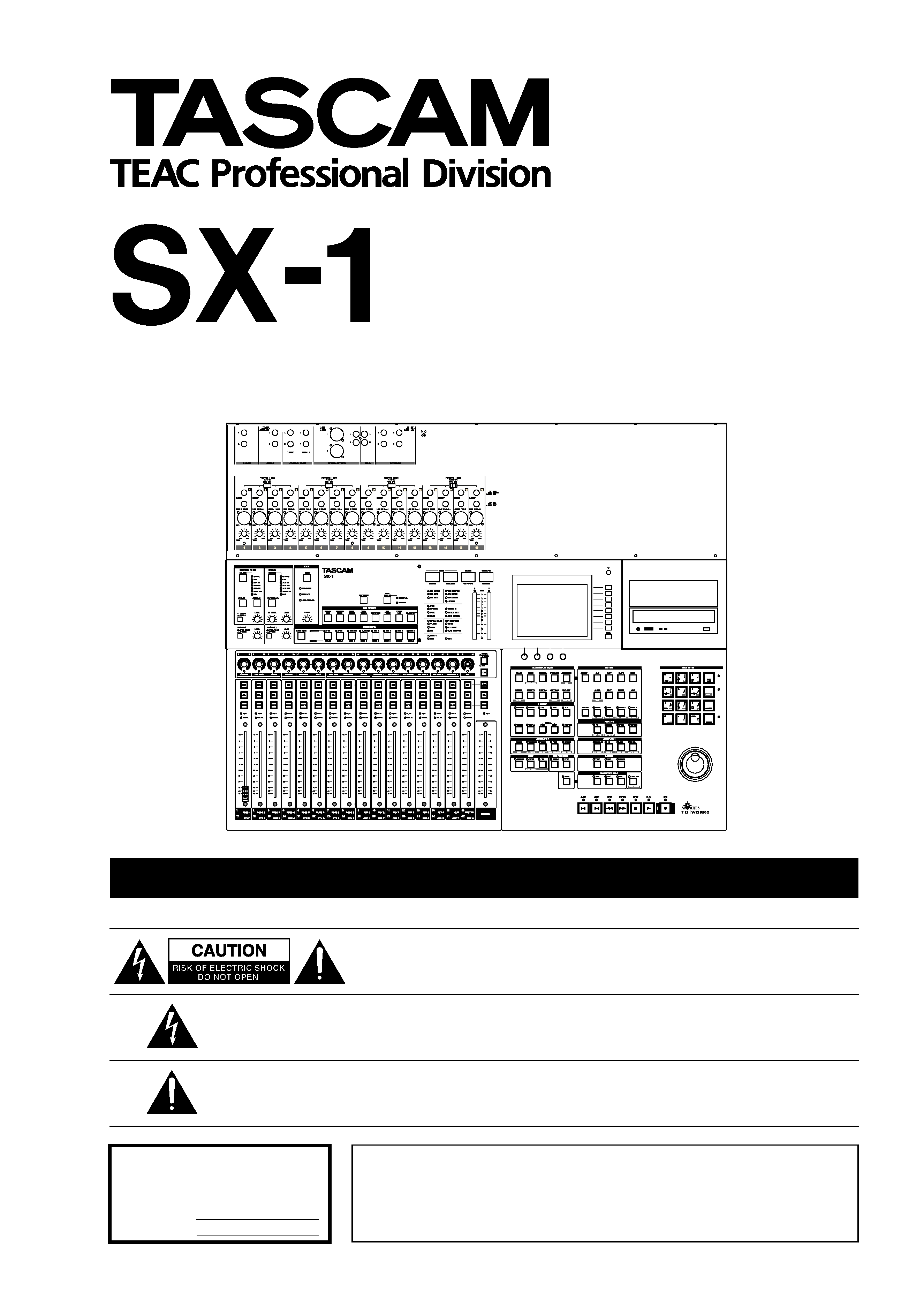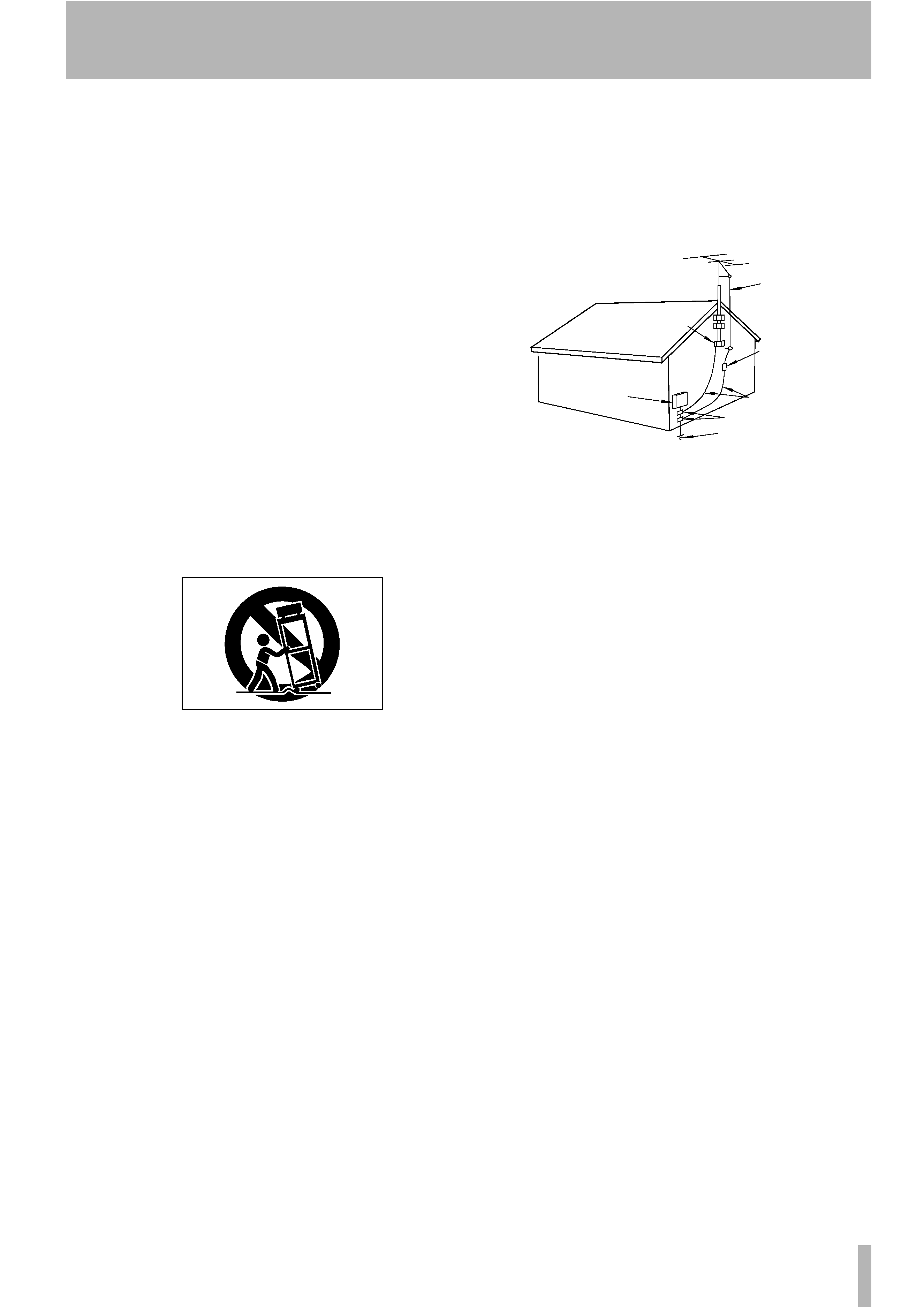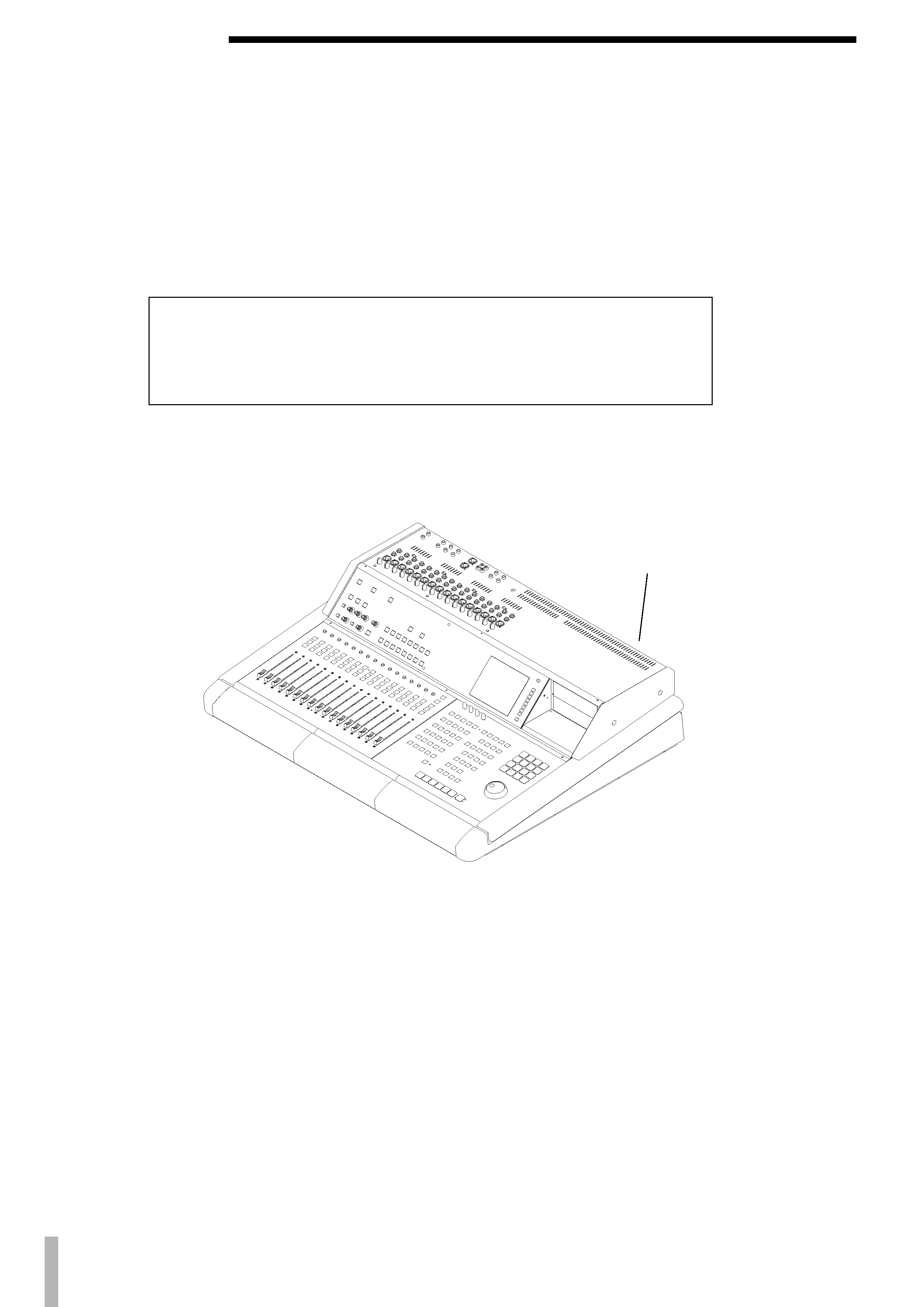
Digital Production Environment
QUICK START GUIDE
CAUTION: TO REDUCE THE RISK OF ELECTRIC SHOCK, DO NOT
REMOVE COVER (OR BACK). NO USER-SERVICEABLE PARTS
INSIDE. REFER SERVICING TO QUALIFIED SERVICE PERSONNEL.
The exclamation point within an equilateral triangle is intended to alert the user to the pres-
ence of important operating and maintenance (servicing) instructions in the literature
accompanying the appliance.
The lightning flash with arrowhead symbol, within an equilateral triangle, is intended to alert
the user to the presence of uninsulated "dangerous voltage" within the product's enclosure
that may be of sufficient magnitude to constitute a risk of electric shock to persons.
This appliance has a serial number
located on the rear panel. Please record
the model number and serial number
and retain them for your records.
Model number
Serial number
WARNING: TO PREVENT FIRE OR SHOCK
HAZARD, DO NOT EXPOSE THIS
APPLIANCE TO RAIN OR MOISTURE.
9101448000

2 TASCAM SX-1 Quick Start Guide
Important Safety Precautions
IMPORTANT (for U.K. Customers)
DO NOT cut off the mains plug from this equipment.
If the plug fitted is not suitable for the power points in your home or
the cable is too short to reach a power point, then obtain an
appropriate safety approved extension lead or consult your dealer.
If nonetheless the mains plug is cut off, remove the fuse and dispose
of the plug immediately, to avoid a possible shock hazard by
inadvertent connection to the mains supply.
If this product is not provided with a mains plug, or one has to be
fitted, then follow the instructions given below:
IMPORTANT:
The wires in this mains lead are coloured in
accordance with the following code:
GREEN-AND-YELLOW
: EARTH
BLUE
: NEUTRAL
BROWN
: LIVE
WARNING:
This apparatus must be earthed.
As the colours of the wires in the mains lead of this apparatus may
not correspond with the coloured markings identifying the terminals
in your plug proceed as follows:
The wire which is coloured GREEN-and-YELLOW must be
connected to the terminal in the plug which is marked by the letter
E or by the safety earth symbol ç or coloured GREEN or GREEN-
and-YELLOW.
The wire which is coloured BLUE must be connected to the terminal
which is marked with the letter N or coloured BLACK.
The wire which is coloured BROWN must be connected to the
terminal which is marked with the letter L or coloured RED.
When replacing the fuse only a correctly rated approved type should
be used and be sure to re-fit the fuse cover.
IF IN DOUBT -- CONSULT A COMPETENT ELECTRICIAN.
TO THE USER
This equipment has been tested and found to
comply with the limits for a Class A digital device,
pursuant to Part 15 of the FCC Rules. These
limits are designed to provide reasonable
protection against harmful interference when the
equipment
is
operated
in
a
commercial
environment. This equipment generates, uses,
and can radiate radio frequency energy and, if
not installed and used in accordance with the
instruction
manual,
may
cause
harmful
interference to radio communications.
Operation of this equipment in a residental area
is likely to cause harmful interference in which
case the user will be required to correct the
interference at his own expense.
CAUTION
Changes or modifications to this equipment not
expressly approved by TEAC CORPORATION
for compliance could void the user's authority to
operate this equipment.
For the consumers in Europe
WARNING
This is a Class A product. In a domestic environment, this
product may cause radio interference in which case the user
may be required to take adequate measures.
Pour les utilisateurs en Europe
AVERTISSEMENT
Il s'agit d'un produit de Classe A. Dans un environnement
domestique, cet appareil peut provoquer des interférences
radio, dans ce cas l'utilisateur peut être amené à prendre
des mesures appropriées.
Für Kunden in Europa
Warnung
Dies is eine Einrichtung, welche die Funk-Entstörung nach
Klasse A besitzt. Diese Einrichtung kann im Wohnbereich
Funkstörungen versursachen ; in diesem Fall kann vom
Betrieber verlang werden, angemessene Maßnahmen
durchzuführen und dafür aufzukommen.
For U.S.A
The equipment draws nominal non-operating power from the
AC outlet with its POWER switch in the off position.

TASCAM SX-1 Quick Start Guide
3
CAUTION:
... Read all of these Instructions.
... Save these Instructions for later use.
... Follow all Warnings and Instructions marked on the audio
equipment.
1) Read Instructions
-- All the safety and operating instructions
should be read before the product is operated.
2) Retain Instructions
-- The safety and operating instructions
should be retained for future reference.
3) Heed Warnings
-- All warnings on the product and in the operating
instructions should be adhered to.
4) Follow Instructions
-- All operating and use instructions should be
followed.
5) Cleaning
-- Unplug this product from the wall outlet before clean-
ing. Do not use liquid cleaners or aerosol cleaners. Use a damp cloth for
cleaning.
6) Attachments
-- Do not use attachments not recommended by the
product manufacturer as they may cause hazards.
7) Water and Moisture
-- Do not use this product near water -- for
example, near a bath tub, wash bowl, kitchen sink, or laundry tub; in a
wet basement; or near a swimming pool; and the like.
8) Accessories
-- Do not place this product on an unstable cart, stand,
tripod, bracket, or table. The product may fall, causing serious injury to a
child or adult, and serious damage to the product. Use only with a cart,
stand, tripod, bracket, or table recommended by the manufacturer, or sold
with the product. Any mounting of the product should follow the manu-
facturer's instructions, and should use a mounting accessory recom-
mended by the manufacturer.
9)
A product and cart combination should be moved with care. Quick
stops, excessive force, and uneven surfaces may cause the product and
cart combination to overturn.
10) Ventilation
-- Slots and openings in the cabinet are provided for
ventilation and to ensure reliable operation of the product and to protect
it from overheating, and these openings must not be blocked or covered.
The openings should never be blocked by placing the product on a bed,
sofa, rug, or other similar surface. This product should not be placed in a
built-in installation such as a bookcase or rack unless proper ventilation
is provided or the manufacturer's instructions have been adhered to.
11) Power Sources
-- This product should be operated only from the
type of power source indicated on the marking label. If you are not sure
of the type of power supply to your home, consult your product dealer or
local power company. For products intended to operate from battery
power, or other sources, refer to the operating instructions.
12) Grounding or Polarization
-- This product may be equipped
with a polarized alternating-current line plug (a plug having one blade
wider than the other). This plug will fit into the power outlet only one
way. This is a safety feature. If you are unable to insert the plug fully into
the outlet, try reversing the plug. If the plug should still fail to fit, contact
your electrician to replace your obsolete outlet. Do not defeat the safety
purpose of the polarized plug.
13) Power-Cord Protection
-- Power-supply cords should be routed
so that they are not likely to be walked on or pinched by items placed
upon or against them, paying particular attention to cords at plugs, con-
venience receptacles, and the point where they exit from the product.
14) Outdoor Antenna Grounding
-- If an outside antenna or cable
system is connected to the product, be sure the antenna or cable system is
grounded so as to provide some protection against voltage surges and
built-up static charges. Article 810 of the National Electrical Code,
ANSI/NFPA 70, provides information with regard to proper grounding
of the mast and supporting structure, grounding of the lead-in wire to an
antenna discharge unit, size of grounding conductors, location of
antenna-discharge unit, connection to grounding electrodes, and require-
ments for the grounding electrode.
"Note to CATV system installer:
This reminder is provided to call the CATV system installer's attention
to Section 820-40 of the NEC which provides guidelines for proper
grounding and, in particular, specifies that the cable ground shall be con-
nected to the grounding system of the building, as close to the point of
cable entry as practical.
15) Lightning
-- For added protection for this product during a light-
ning storm, or when it is left unattended and unused for long periods of
time, unplug it from the wall outlet and disconnect the antenna or cable
system. This will prevent damage to the product due to lightning and
power-line surges.
16) Power Lines
-- An outside antenna system should not be located
in the vicinity of overhead power lines or other electric light or power
circuits, or where it can fall into such power lines or circuits. When
installing an outside antenna system, extreme care should be taken to
keep from touching such power lines or circuits as contact with them
might be fatal.
17) Overloading
-- Do not overload wall outlets, extension cords, or
integral convenience receptacles as this can result in risk of fire or elec-
tric shock.
18) Object and Liquid Entry
-- Never push objects of any kind into
this product through openings as they may touch dangerous voltage
points or short-out parts that could result in a fire or electric shock. Never
spill liquid of any kind on the product.
19) Servicing
-- Do not attempt to service this product yourself as
opening or removing covers may expose you to dangerous voltage or
other hazards. Refer all servicing to qualified service personnel.
20) Damage Requiring Service
-- Unplug this product from the
wall outlet and refer servicing to qualified service personnel under the
following conditions:
a)
when the power-supply cord or plug is damaged.
b)
if liquid has been spilled, or objects have fallen into the product.
c)
if the product has been exposed to rain or water.
d)
if the product does not operate normally by following the operating
instructions. Adjust only those controls that are covered by the operating
instructions as an improper adjustment of other controls may result in
damage and will often require extensive work by a qualified technician to
restore the product to its normal operation.
e)
if the product has been dropped or damaged in any way.
f )
when the product exhibits a distinct change in performance this
indicates a need for service.
21) Replacement Parts
-- When replacement parts are required, be
sure the service technician has used replacement parts specified by the
manufacturer or have the same characteristics as the original part.
Unauthorized substitutions may result in fire, electric shock, or other
hazards.
22) Safety Check
-- Upon completion of any service or repairs to this
product, ask the service technician to perform safety checks to determine
that the product is in proper operating condition.
23) Wall or Ceiling Mounting
-- The product should be mounted to a
wall or ceiling only as recommended by the manufacturer.
24) Heat
-- The product should be situated away from heat sources such
as radiators, heat registers, stoves, or other products (including amplifi-
ers) that produce heat.
ANTENNA
LEAD IN
WIRE
ANTENNA
DISCHARGE UNIT
(NEC SECTION 810-20)
G
ROUNDING CONDUCTORS
(NEC SECTION 810-21)
GROUND CLAMPS
POWER SERVICE GROUNDING
ELECTRODE SYSTEM
(NEC ART 250. PART H)
NEC - NATIONAL ELECTRICAL CODE
ELECTRIC
SERVICE
EQUIPMENT
Example of Antenna Grounding as per
National Electrical Code, ANSI/NFPA 70
GROUND
CLAMP
IMPORTANT SAFETY INSTRUCTIONS

4 TASCAM SX-1 Quick Start Guide
SAFETY INFORMATION
This product has been designed and manufactured according to FDA regulations "title 21, CFR, chapter 1, subchapter J, based on
the Radiation Control for Health and Safety Act of 1968", and is classified as a class 1 laser product. There is no hazardous invisi-
ble laser radiation during operation because invisible laser radiation emitted inside of this product is completely confined in the
protective housings.
The label required in this regulation is shown in 1.
CAUTION
- DO NOT REMOVE THE PROTECTIVE HOUSING USING A SCREWDRIVER.
- USE OF CONTROLS OR ADJUSTMENTS OR PERFORMANCE OF PROCEDURES OTHER THAN THOSE SPECIFIED HEREIN MAY
RESULT IN HAZARDOUS RADIATION EXPOSURE.
- IF YOU SHOULD EXPERIENCE ANY PROBLEMS WITH THIS PRODUCT THAT CANNOT BE RESOLVED WITH THE "TROUBLE-
SHOOTING" SECTION LATER IN THIS MANUAL, CONTACT A TEAC AUTHORIZED SERVICE AGENCY. DO NOT CONTINUE TO
USE THE PRODUCT UNTIL THE PROBLEM IS RESOLVED.
Optical pickup :
Type:
KRS-202A or KRS-220B
Manufacturer:
SONY Corporation
Laser output:
Less than 0.1 mW (play) and 32mW
(record) on the objective lens
Wavelength:
777 - 787 nm
1

Table of Contents
TASCAM SX-1 Quick Start Guide
5
Chapter 1 Introduction
SX-1 Standard Features ..................................6
Unpacking .......................................................7
Box Contents...................................................7
Registration.....................................................7
Options ............................................................7
Support and Updates .....................................7
Using These Manuals ................................. 8
Quick Start Guide............................................8
Owner's Manual .............................................8
Using the Internet...........................................8
Documentation Conventions .........................8
Hot Tips .......................................................8
Operating Conventions.............................. 9
Multi-Function Keys........................................9
Virtual Channel Pots .......................................9
VGA Screen Navigation ..................................9
LCD Screen Navigation ...................................10
LCD or VGA......................................................10
Fader Banks .....................................................11
Chapter 2 Getting Started
Speaker Placement .........................................13
VGA Monitor Placement.................................13
Mouse and Keyboard .....................................13
Plugging Into Power.......................................13
Don't Interrupt! ..........................................13
"Safe" startup .............................................13
Shutting down your SX-1 ..........................14
Being Grounded ..........................................14
Avoiding Ground Loops .............................14
Chapter 3 Making Connections
Getting Sound ............................................ 15
Phones .............................................................15
Studio ..............................................................15
Control Room ..................................................15
Master Stereo Outs.........................................16
Basic Wiring Diagram ................................. 16
Important Rear Connections...................... 17
Loading the Demo Song ............................ 18
Loading the Audio Demo Song .....................18
Chapter 4 MIDI Basics
Connecting MIDI ......................................... 20
Loading the MIDI Song Demo ................... 21
MIDI Instrument Track Assignment...............21
MIDI Instrument Track Assignment...............21
Chapter 5 Essential Moves
Back Up and Shutdown ............................. 23
Backing Up ......................................................23
From the VGA screen......................................23
From the LCD screen.......................................24
Shutdown Procedure ................................. 24
Chapter 6 Taking Control
Audio Monitoring........................................... 26
Information Display ....................................... 26
Mix Control ..................................................... 26
Settings Management.................................... 26
MIDI ................................................................. 27
Editing ............................................................. 27
Transport and Data Entry .............................. 27
Chapter 7 Basic Moves
Getting Around ........................................... 28
A Quick Explanation of a Few Important
Terms ........................................................ 28
Slot .............................................................. 28
Take ............................................................. 28
Clip .............................................................. 28
Channel ....................................................... 28
Mutes and Solos ......................................... 29
Creating a New Project............................... 29
On the VGA..................................................... 29
On the LCD...................................................... 30
To Record an Audio Track .......................... 30
On the VGA..................................................... 30
On the LCD...................................................... 31
Recording MIDI............................................ 32
On the VGA..................................................... 32
On the LCD...................................................... 32
Using Locate Points and Autopunch ......... 33
A word about the CAPTURE key ............... 33
Setting a locate point..................................... 33
Recalling a Locate Point ................................. 33
Using Autopunch ........................................ 33
Updating the SX-1 software ...................... 34
Chapter 8 A quick look at a few
shortcuts
Make a quick headphone mix.................... 35
Make 5 different mixes for different players
quickly....................................................... 35
Quickly move all of your faders (on the current
layer) back to unity.................................. 35
Quickly make a Fader Group...................... 35
Quickly Solo-Safe a channel (or channels) 35
Quickly link a pair of channels on the
console...................................................... 36
Quickly mixdown a number of sources to a
stereo pair ................................................ 36
Quickly use the LCD and the VGA screens to
show separate things .............................. 36
Track a drum kit, even though you have no
free mixer channels ................................. 36
Quickly select every MIDI note on a MIDI
Take........................................................... 37
Quickly name a number of similar types of
things ........................................................ 37
